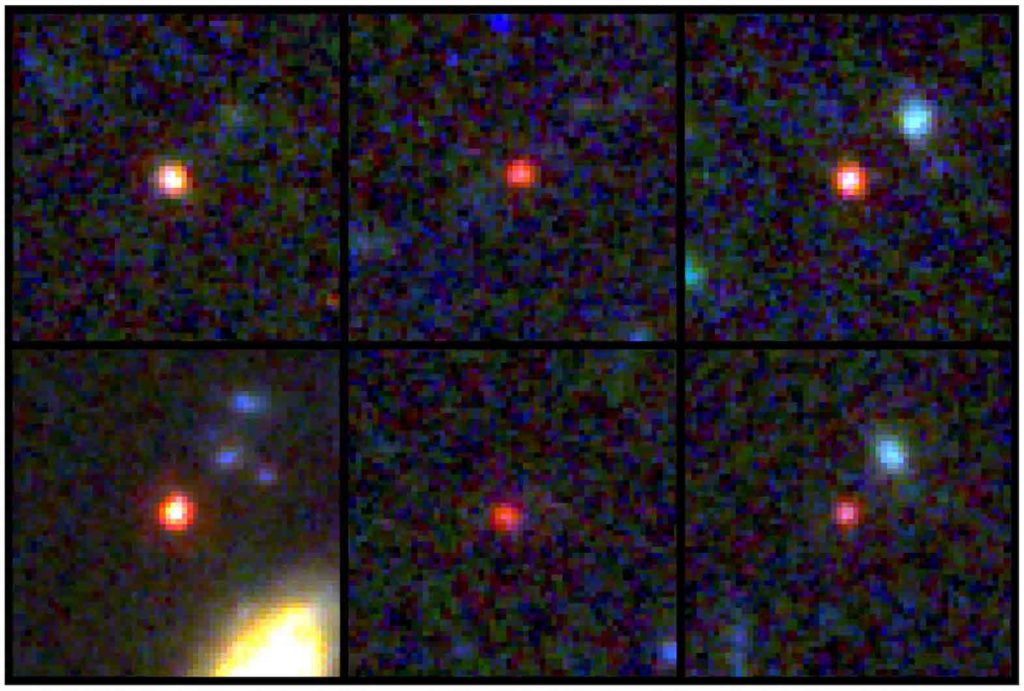Galaxies spotted by Webb telescope rewrite understanding of early universe

Images of six candidate massive galaxies, seen 540 million to 770 million years after the Big Bang, are shown in this undated handout image based on observations by NASA’s James Webb Space Telescope, as one of them (bottom left) could contain as many stars as our present-day Milky Way, but is 30 times more compact. NASA, ESA, CSA, I. Labbe (Swinburne University of Technology)/Handout via REUTERS
WASHINGTON – Observations by NASA’s James Webb Space Telescope are upending the understanding of the early universe, indicating the presence of large and mature but remarkably compact galaxies teeming with stars far sooner than scientists had considered possible.
Astronomers said data obtained by the telescope reveals what appear to be six big galaxies as mature as our Milky Way existing about 540 million to 770 million years after the explosive Big Bang that kicked off the universe 13.8 billion years ago. The universe was roughly 3% of its current age at the time.
These galaxies, one of which appears to have a mass rivaling our Milky Way but 30 times more densely packed, seem to differ in fundamental ways from those populating the universe today.
“Oh, they are radically different – truly bizarre creatures,” said astrophysicist Ivo Labbe of Swinburne University of Technology in Australia, lead author of the study published in the journal Nature. “If the Milky Way were a regular-sized average adult, say about 5’9″ (1.75 meters) and 160 pounds (70 kg), these would be 1-year-old babies weighing about the same but standing just under 3 inches (7 cm) tall. The early universe is a freak show.”
Webb was launched in 2021 and began collecting data last year. The findings were based upon the first dataset released by NASA last July from Webb, a telescope boasting infrared-sensing instruments able to detect light from the most ancient stars and galaxies.
“This is an astounding discovery and unexpected. We thought that galaxies form over much longer periods of time,” said Penn State astrophysicist and study co-author Joel Leja. “No one expected to find these. These galaxy candidates are simply too evolved for our expectations. They seem to have evolved faster than allowed by our standard models.”
Leja called them galaxy candidates because further observations are needed to confirm that they all are galaxies rather than some other source of light like a supermassive black hole.
“The exciting part is that even if only some turn out to be massive galaxies, these things are so massive that they alone would upend our measurements of the total mass in stars at this time. It would suggest 10 to 100 times more mass in stars existing at this epoch than expected and would imply that galaxies form way, way faster in the universe than anyone thought.”
The galaxies appear to contain mass equivalent to 10 billion to 100 billion times that of our sun. The latter figure is similar to the Milky Way’s mass.
The journey to galaxy formation following the Big Bang apparently hinged on mysterious material called dark matter that is invisible to us but is known to exist because of the gravitational influence it exerts on normal matter.
“The leading theory is that an ocean of dark matter filled the early universe after the Big Bang,” Labbe said.
“This dark matter – we don’t know what it is actually is – started out really smooth, with only the tiniest of ripples. These ripples grew over time due to gravity and eventually the dark matter started to collect in concentrated clumps, dragging hydrogen gas along for the ride. It’s that hydrogen gas that will eventually turn into stars. Clumps of dark matter, gas and stars is what we call a galaxy,” Labbe added.
Astronomers suspect the first stars began forming 100 million to 200 million years after the Big Bang, each perhaps 1,000 more massive than our sun but much shorter-lived.
“Their explosion set off the chain of events that formed subsequent generations of stars,” Labbe said.
“Webb continuous to amaze and surprise us,” Labbe added. “So yes, the early universe was a lot richer and lot more diverse – monsters and dragons. And the curtain is still being lifted.”

